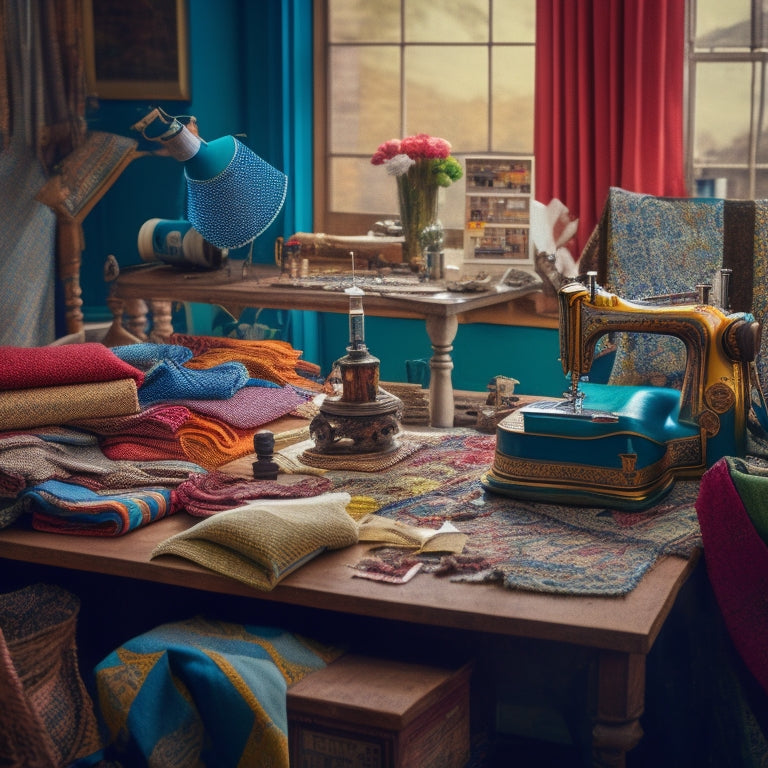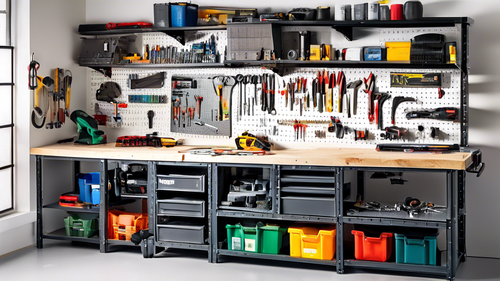
Sewing Secrets Unleashed: Expert Tips and Projects
Share
I'm about to spill my sewing secrets! To master multiple projects, I follow the rule of three and prioritize time management to avoid procrastination. In-the-hoop coaster creations are a fun way to practice techniques and reduce fabric waste. I also love sewing for charity - it's rewarding to craft blankets for those in need. Machine embroidery is another passion of mine; I've mastered the basics and know the importance of stabilizers and design placement. Now, I'm excited to share more expert tips and projects with you, from essential sewing techniques to creative project ideas, and I'm just getting started - there's so much more to uncover!
Key Takeaways
• Master multiple sewing projects simultaneously by embracing the rule of three for project limitation and maintaining creative balance and focus.
• Elevate ready-made garments with machine embroidery by choosing suitable stabilizers, pre-washing garments, and utilizing design templates for precise placement.
• Avoid common sewing mistakes by pre-washing fabric, respecting the grainline, using the right needle, and setting correct tension.
• Create unique and personalized gifts or home decor items by experimenting with different materials and techniques for in-the-hoop coaster creations.
• Develop essential sewing skills by mastering machine embroidery basics, understanding digitizing techniques, and focusing on embroidery placement and stabilizers.
Mastering Multiple Projects
When it comes to juggling multiple sewing projects, I've found that the key to success lies in embracing the 'rule of three,' which means limiting my active projects to a maximum of three at any given time.
This approach allows me to maintain creative balance and focus on each project individually, ensuring I make progress without feeling overwhelmed. Effective time management is pivotal in this process, as it enables me to allocate sufficient time for each project and avoid procrastination.
In-the-Hoop Coaster Creations
With my embroidery machine at the ready, I love whipping up in-the-hoop coasters that make perfect personalized gifts or add a touch of elegance to my own home decor. These small yet thoughtful creations are a great way to practice my crafting techniques and reduce waste by recycling fabric scraps that would otherwise end up in thrift shops.
| Fabric Type | Stabilizer | Tips |
|---|---|---|
| Cotton | Tear-away | Use a light stabilizer for delicate designs |
| Felt | Water-soluble | Perfect for intricate cut-outs and appliques |
| Vinyl | Cut-away | Ideal for outdoor or high-traffic areas |
| Fleece | Fusible web | Adds a soft, plush touch to coasters |
| Denim | Medium-weight | Great for rustic, country-inspired designs |
Blanket Bonanza for Charity
I'm thrilled to share my latest charity sewing project, Blanket Bonanza, where I'm creating a trio of adorable blankets to donate to a local hospital for those in need.
This project is close to my heart, as I believe that crafting for a cause can have a profound charitable impact. I've chosen three unique fabrics and techniques to create these special blankets, each one designed to bring comfort and joy to its recipient.
Machine Embroidery Essentials
Mastering machine embroidery essentials is key to unlocking your creativity and producing stunning, professional-looking results. As I explore the world of machine embroidery, I've come to realize that understanding digitizing techniques and embroidery placement is essential for achieving flawless designs. Here's a breakdown of the essentials to get you started:
| Digitizing Techniques | Embroidery Placement | Tips and Tricks |
|---|---|---|
| Understanding stitch varieties | Measuring the design area | Use a stabilizer for smooth results |
| Editing designs for fabric material | Hooping for precise placement | Test designs on similar fabric |
| Creating personalized designs | Using templates for accuracy | Pre-wash garments for optimal results |
Embroidering on Readymades
My favorite way to breathe new life into ready-made garments is by adding a touch of machine embroidery, which can instantly elevate a plain tee or jeans into a one-of-a-kind fashion statement.
With the right techniques and tools, you can turn ordinary clothes into extraordinary pieces that reflect your personal style. Here are some essential tips to keep in mind:
-
Choose the appropriate stabilizer: Select a stabilizer that suits the type of fabric you're working with to guarantee a smooth embroidery process.
-
Pre-wash garments: Wash the garment before embroidering to prevent shrinkage and excess dye.
-
Utilize design templates: Use software programs to print templates for precise design placement.
- Hoop garments flat: Embroider on garments that can be opened up flat for better results.
Heirloom Sewing Traditions
What defines heirloom sewing, and how can we integrate these timeless traditions into our modern-day sewing projects?
As I explore the world of heirloom sewing, I'm struck by the beauty of vintage techniques that evoke a sense of nostalgia and elegance. From delicate lace to intricate embroidery, these traditional methods add a touch of sophistication to any project.
But how can we make them relevant in today's fast-paced world? By infusing modern twists, of course! By combining vintage techniques with contemporary fabrics and designs, we can create unique pieces that are both timeless and trendy.
Whether it's a bespoke baby blanket or a customized wedding veil, heirloom sewing traditions can be adjusted to fit our modern aesthetic, resulting in truly captivating creations.
Community Engagement Matters
As I connect with fellow sewing enthusiasts through online forums, social media, and in-person meetups, I'm reminded that community engagement is the spark that ignites creativity, fosters growth, and transforms our sewing journeys from solitary pursuits to collective celebrations of creativity.
By participating in sewing events, attending workshops, and volunteering for charity projects, we can tap into a wealth of knowledge, inspiration, and support.
Here are a few ways to get involved:
-
Join online sewing communities to connect with like-minded individuals, share tips, and learn from others.
-
Attend sewing events to network with fellow enthusiasts, learn from experts, and stay updated on the latest trends.
-
Participate in volunteer opportunities to give back to the community, develop new skills, and build lasting connections.
- Host your own sewing meetups to bring people together, share knowledge, and foster a sense of belonging.
Delving Into Digitizing Art
By exploring the world of digitizing, I've discovered a new domain of creative possibilities that allow me to bring my embroidery designs to life.
With digitizing techniques, I can transform my artistic visions into stunning embroidery pieces. I've learned to edit free designs and create new ones from existing ones, giving me endless opportunities to express my creativity.
The process of digitizing has opened up a world of artistic embroidery, where I can experiment with different styles, colors, and textures. I'm no longer limited by pre-made designs; instead, I can create unique and personalized pieces that reflect my individuality.
With the right software and techniques, the possibilities are endless, and I'm excited to continue exploring this fascinating world of digitizing art.
Sewing for a Higher Purpose
Through the simple act of stitching together a blanket or sewing a garment, I've discovered that I can make a tangible difference in someone's life, and that's a truly powerful feeling. Charity sewing has become a significant part of my sewing journey, and I'm excited to share some ways you can get involved too!
Here are a few ways you can start giving back through sewing:
-
Donate to local hospitals: Many hospitals accept handmade blankets, hats, and other items for patients in need.
-
Support organizations like Project Linus: This organization provides handmade blankets to children in need, and you can get involved by sewing and donating blankets.
-
Participate in charity sewing events: Look for local sewing groups or online communities that organize charity sewing events, where you can sew and donate items together.
- Sew for a specific cause: Whether it's sewing masks for healthcare workers or making blankets for the homeless, choose a cause that resonates with you and get sewing!
Organizing Your Sewing Space
Now that I've decluttered my sewing projects, it's time to tackle the challenging task of organizing my sewing space. As I reflect on my workspace, I realize that a well-organized space is essential for productivity and creativity.
To start, I'll focus on fabric storage. I'll use bins and baskets to categorize my fabrics by type, color, and project.
Next, I'll tackle my sewing supplies, grouping similar items together and storing them in easy-to-reach locations.
Decluttering tips I've learned along the way will help me maintain this organized space. By implementing these simple strategies, I'll be able to find what I need quickly, allowing me to focus on what I love – sewing!
Frequently Asked Questions
How Do I Prevent Fabric From Fraying When Cutting Out Patterns?
"When cutting out patterns, I prevent fabric from fraying by using fabric folding techniques and fray prevention methods like serging or zigzagging edges, and finishing seams with techniques like binding or Hong Kong seams."
What Is the Best Way to Store and Organize Threads and Yarns?
Like a treasure chest overflowing with colorful riches, my thread and yarn stash needs taming! I store them in thread spool racks and yarn storage containers, keeping them tidy and easily accessible for my next creative adventure.
Can I Use a Regular Sewing Machine for Quilting Large Projects?
"I can use my regular sewing machine for small quilting projects, but for larger ones, I'll need specialized quilting techniques and tools, like a longarm machine or hand quilting, to achieve professional results."
How Do I Keep My Embroidery Machine's Tension Consistent and Accurate?
I maintain consistent tension on my embroidery machine by regularly cleaning and lubricating my embroidery hoop, and troubleshooting bobbin issues - a game-changer for precise stitches and frustration-free embroidery sessions!
Are There Any Specific Needles Recommended for Sewing Through Thick Fabrics?
Ugh, thick fabrics, am I right? Okay, seriously, for sewing through thick fabrics, I swear by Denim needles and leather needles - they're game-changers! Regularly clean and maintain your sewing machine to avoid tension issues, and you're golden!
Related Posts
-

Garage Workbench Organization
Garage Workbench Organization: A Guide to Maximizing Space and Efficiency Are you tired of a cluttered and unorgan...
-

What Makes a Custom Closet Storage System Perfect?
When it comes to creating a perfect custom closet storage system, you need a balance of form and function. You want t...
-

10 Essential Tips to Organize Your Compact Kitchen
You're about to change your compact kitchen into a highly functional and organized space that makes meal prep a breez...


